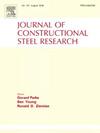Study on the overall stability of real fire under suspendome structures
IF 4
2区 工程技术
Q1 CONSTRUCTION & BUILDING TECHNOLOGY
引用次数: 0
Abstract
Suspendome structures are commonly employed in large-span public buildings. Fire represents a prevalent hazard in structures, posing significant risks to public safety. This study introduced a comprehensive analytical approach for evaluating the overall stability performance of suspendome under fire. The thermodynamic response of a suspendome, with a span of 60 m and a span-ratio of 1/6, was analyzed under the central fire with a thermal power of 20 MW. The study investigated the overall stability performance of structures under fire, accounting for both the fire source and the structural geometric parameters. The theoretical calculation formulas of the ultimate capacity reduction coefficient in the fire process of the suspendome were presented. The study found that, under identical fire power, the overall stability of the structure was more significantly impacted by fire as the span of the structure increased and the span-ratio decreased. Furthermore, the higher the fire power and the more distance of the fire from the center, the more pronounced the effect on the stability of the suspendomes. The findings of this research offer a theoretical foundation for the selection of structural configurations and fire design strategies for suspendome structures.
悬索式结构火灾实景下整体稳定性研究
悬索结构是大跨度公共建筑中常用的结构形式。火灾是建筑物中普遍存在的危险,对公共安全构成重大威胁。本文介绍了一种综合分析方法来评价悬架在火力作用下的整体稳定性能。分析了一个跨度为60 m、跨度比为1/6的吊索在20 MW热功率的中心火灾下的热力学响应。考虑火源和结构几何参数,研究了火灾下结构的整体稳定性能。给出了吊杆火灾过程中极限容量缩减系数的理论计算公式。研究发现,在火灾功率相同的情况下,随着结构跨度的增大和跨比的减小,火灾对结构整体稳定性的影响更为显著。此外,火力越大,距离中心越远,对悬架稳定性的影响越明显。研究结果为悬架结构的结构形式选择和防火设计策略提供了理论依据。
本文章由计算机程序翻译,如有差异,请以英文原文为准。
求助全文
约1分钟内获得全文
求助全文
来源期刊

Journal of Constructional Steel Research
工程技术-工程:土木
CiteScore
7.90
自引率
19.50%
发文量
550
审稿时长
46 days
期刊介绍:
The Journal of Constructional Steel Research provides an international forum for the presentation and discussion of the latest developments in structural steel research and their applications. It is aimed not only at researchers but also at those likely to be most affected by research results, i.e. designers and fabricators. Original papers of a high standard dealing with all aspects of steel research including theoretical and experimental research on elements, assemblages, connection and material properties are considered for publication.
 求助内容:
求助内容: 应助结果提醒方式:
应助结果提醒方式:


